The Beauty and Science Behind Geodes
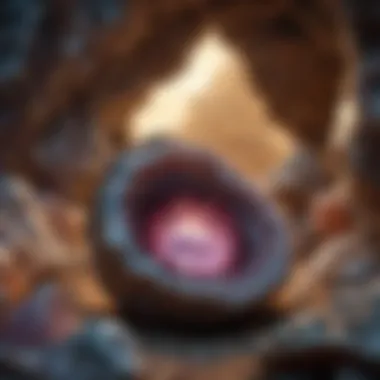
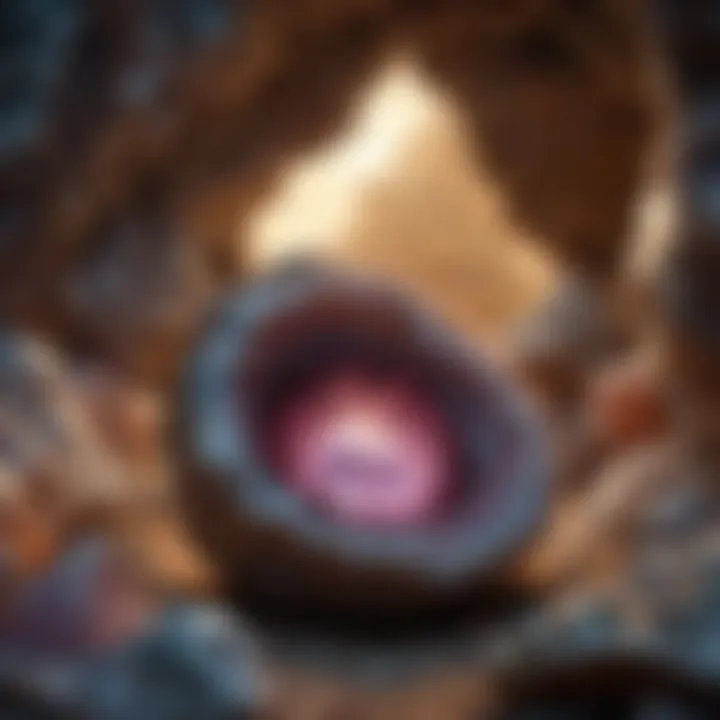
Intro
Geodes are fascinating natural formations that capture the imaginations of many, particularly among those who collect rocks and fossils. Their mesmerizing beauty, stemming from the myriad of colorful crystals encased within their hollow interiors, begs the question of how these geological spectacles come to be. In this exploration, we will navigate through the aesthetic and scientific aspects of geodes, shedding light on not just their surface allure but also their intricate origins and classifications. A deeper understanding of these unique geological wonders not only enriches one's appreciation as a collector but also provides context for the natural processes that shape our planet.
History and Origins
Overview of Collectibles, Rocks, and Fossils
Geodes have found their place in the spirits of collectors for centuries. These cosmic treasures are not merely rocks; they are pockets of history, narrating tales from the earth’s past. To appreciate their beauty, it’s essential to grasp their formation, which often requires volcanic or hydrothermal activity. As such, these formations serve as a barometer for the environmental conditions they formed under, making them a cherished collectible among geology enthusiasts and historians alike.
Historical Significance and Cultural Impact
Throughout history, geodes have sparked fascination across cultures, appearing in folklore and geological studies. In Ancient Rome, for example, these natural phenomena were considered symbols of transformation and beauty. Some cultures considered their crystal interiors as portals to the divine, attributing them with spiritual significance. The beauty and mystique of geodes often led to their appearances in jewelry, art, and even medicine. Collectors today find themselves drawn to both the aesthetic qualities and the storied pasts of each individual geode, contributing to a rich tapestry of cultural appreciation.
Identification and Classification
Guide to Identifying Rocks and Fossils
The art of identifying geodes involves a blend of knowledge and intuition. Collectors must familiarize themselves with certain key indicators: the size, shape, outer texture, and weight of potential geodes can all provide hints toward their content. Often, the best specimens display a circular or oval structure and can be distinguished from ordinary stones by their distinctive patterns and texture.
Common Types and Variations
Geodes come in a wide array of shapes and sizes, each unique due to the specific conditions of their formation. Some of the common types include:
- Amethyst Geodes: Famous for their striking purple crystals, these geodes are often sought after for their beauty and supposed metaphysical properties.
- Calcite Geodes: These may have a variety of colors and formations, presenting a unique vibrance that attracts many collectors.
- Agate Geodes: Known for their layered and banded appearance, agate geodes can display a spectrum of hues, making them a colorful addition to any collection.
In essence, taking the time to learn about the different types of geodes not only enhances your collecting experience but also enriches your knowledge of our planet's geological complexities. Each geode you encounter offers a glimpse into the Earth's artistry, shaped by the forces of time and nature.
“The world of geodes is vast and full of surprises; each stone tells its own unique story.”
Understanding these geological wonders, their origins, and their classification sets the stage for a deeper appreciation of the aesthetic qualities they possess. In our pursuit of knowledge, we unravel the mysteries that these natural artifacts hold, leading us closer to the heart of the Earth itself.
Prelims to Geodes
Geodes hold a unique place in the realm of natural curiosities, whispering tales of geological marvels and aesthetic wonders. Their fascinating journey from formation in the depths of the Earth to captivating display pieces in collectors’ homes is a narrative that combines scientific inquiry with an appreciation of beauty. Understanding geodes involves diving into both the tangible characteristics that define them and the invisible forces that shape their creation over millions of years.
The significance of geodes extends beyond mere aestheticism. These geological formations provide insights into our planet’s history and the processes that govern mineral deposition and crystallization. For rock and fossil collectors, geodes represent an intersection of art and science, serving as both a subject for study and an object of admiration. Exploring what constitutes a geode, as well as their historical backdrop, lays the foundation for a deeper understanding of their allure and importance.
Defining Geodes
To grasp the essence of geodes, one must first come to terms with what exactly defines these intriguing formations. Essentially, a geode is a hollow rock nodule lined with crystals or other minerals. The outer layer is typically composed of a tight packing of mineral-rich sediment or volcanic rock which surrounds the inner cavity. This cavity can contain a breathtaking array of crystalline structures, colored in various hues due to the minerals present.
Geodes can vary widely in size. Some are mere pebble-sized wonders, while others can be large enough to serve as furniture pieces. Their shapes are largely spherical but can also take on more irregular forms depending on the geological conditions under which they were formed. Understanding the structural components of geodes elucidates not only their physical properties but also the journey that led to their existence.
Historical Significance
The historical context of geodes stretches back to ancient civilizations that first encountered these geological wonders. Early cultures, such as the Romans and Greeks, utilized crystals within geodes for various purposes, from jewelry to metaphysical practices. Geodes were thought to have protective properties, believed to bring luck or ward off evil spirits. As time marched on, the appreciation for geodes evolved, transitioning from superstitious beliefs to a recognition of their scientific value.
In the 19th century, the world began to open its eyes wider to geology as a scientific field. Collectors and geologists alike indulged in the beauty of geodes, which became a staple in mineral collections. This period saw significant discoveries, especially in regions like Brazil and the United States, where large geode deposits were unearthed.
Geodes’ historical relevance goes beyond just their beauty and utility; they offer a timeline of Earth’s geological changes. Studying their formations and mineral contents can yield insights about shifts in the environment during different epochs. Each geode presents a snapshot of natural history, bridging the past with present understanding, making their significance multifaceted.
"Geodes unravel layers of Earth’s history—each crystal a testament to time’s slow artistry."
In summary, the introduction to geodes encompasses both their physical definition as crystalline rock formations and the rich tapestry of history interwoven with their existence. This sets the stage for exploring their physical characteristics and the geological processes that give birth to these remarkable structures.
Physical Characteristics of Geodes
The physical characteristics of geodes serve as a window into the complexities and wonders of these natural phenomena. From their outer shells to the dazzling interiors, understanding these traits not only increases our appreciation but also ties into the overall geological narrative of our planet. Geodes can be likened to nature's treasure chests, with their outer simplicity belying the beauty contained within. Adjusting one's focus to the specific elements of geodes—like their shape, color, and the crystals inside—reveals much about their formation and environmental significance.
Outer Appearance
Shape and Size Variability
The shape and size of geodes can differ significantly, contributing richly to their visual appeal and geological importance. They can be round, oval, or even irregularly shaped, reflecting the diverse conditions under which they formed. This variability is a key characteristic that not only draws collectors in but also provides insights into the geological conditions present during their formation. For example, geodes found in volcanic areas often exhibit more cylindrical shapes, whereas those in sedimentary settings may display a range of sizes and irregular forms.
One unique feature of this variability in shape and size is how it can influence the type of crystal formation within. Larger geodes tend to host bigger crystals, which can create an awe-inspiring visual drama when cut open. However, smaller geodes may yield just as stunning displays with tightly packed, smaller crystals. This aspect invites collectors to focus not only on size but the potential hidden treasures contained within, making each discovery a unique experience.
Surface Texture and Coloration
The surface texture and coloration of geodes are not just artistic elements; they carry significant information about the geological processes involved in their formation. Geodes can be smooth or rough, exhibiting textures that range from glassy to grainy. Furthermore, colors can vary from muted earth tones to vibrant hues caused by the mineral content. For example, iron oxide can impart shades of reddish-brown, while manganese can lead to purples and pinks.
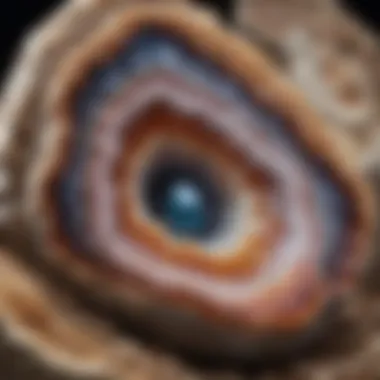
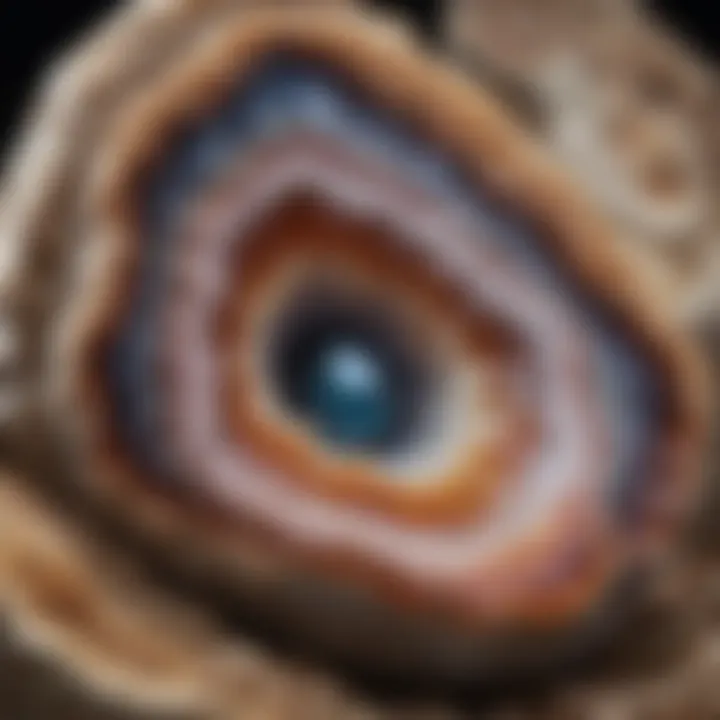
This characteristic is crucial for collectors who often seek specific colors or textures for aesthetic or display purposes. A particularly striking example might include a geode with a fibrous texture and deep blue color that can become a focal point in any collection. The decision to acquire a geode often hinges on these visual characteristics; however, understanding their formation can deepen the collector's appreciation.
Interior Features
Types of Crystals Found
Inside geodes, one can find a myriad of crystal types, which are often the crown jewels of these geological formations. Commonly, quartz or calcite crystals are present, along with more exotic types like agate and amethyst. This variety is significant as it not only enhances the aesthetic allure but also attributes specific geological stories to each geode.
For instance, amethyst geodes contain vibrant purple quartz crystals that are highly sought after both for their beauty and purported metaphysical properties. The presence of different types of crystals within a single geode can also indicate varying environmental conditions during formation, enriching our understanding of the historical context of these geological formations.
Color and Luster Variations
The color and luster of crystals found within geodes also contribute to their overall appeal and scientific value. Crystals can shine with a glassy luster, or they may appear more dull, which can reflect factors like purity and the atmosphere in which they developed. Each crystal’s color can range from soft whites to deep blues, depending largely on the elements present during its formation.
This variation plays a crucial role in how collectors and enthusiasts assess geodes. For example, a vibrant yellow citrine geode captures the eye and the imagination, making it a standout among more neutral colored geodes. Understanding these variations helps collectors determine the quality and potential market value, further encouraging appreciation for these natural wonders.
The beauty of a geode lies not only in its exteriors but most profoundly in the intricate tapestry of crystals that reside within.
Formation of Geodes
Understanding the formation of geodes offers insight into both their aesthetic beauty and the scientific processes behind their development. It reveals how these captivating structures are forged within the earth, shaped by various geologic forces over time. The foundation of this natural artistry lies in the geological processes that facilitate their formation, as well as the time factors that dictate crystal growth. Knowing these elements enhances collectors' appreciation and informs their selection criteria when seeking authentic specimens.
Geological Processes
Volcanic Activity
Volcanic activity plays a crucial role in the formation of geodes. When molten rock, or magma, cools and solidifies, it can create gas bubbles. These bubbles become the seed for geodes. A distinctive characteristic of this process is that it produces hollow cavities in the volcanic rock, making it ideal for geode formation. What sets volcanic activity apart is its often rapid cooling process, which can create intricately shaped crystals inside the geodes.
Benefits of volcanic processes include:
- The potential for unique crystal formations.
- The variety of minerals that can be captured within the cavities.
However, not all volcanic instances lead to the formation of geodes. The availability of the right conditions—such as mineral-rich fluids is essential, which may limit the number of geodes produced.
Sedimentary Environments
Conversely, sedimentary environments contribute to geode formation through biological processes or chemical precipitation. These environments may offer different vessels for mineral solutions that can crystallize over time. A key characteristic here is how they develop from layers of sediment accumulating around a central cavity. As minerals leach from the surrounding materials, they gradually deposit within the cavity, leading to beautiful crystalline growth.
The advantages of these environments include:
- The potential for diverse mineral content captured in the geodes due to varying sediments.
- Slow formation, which can lead to well-defined and more intricate crystals.
The downside includes longer time frames for formation and the chance that geological upheavals may eradicate some of these special environments.
Time Factors
The factors of time are equally significant when discussing how geodes form. Time isn’t just a ticking clock; it plays a vital role in the beauty and complexity of the interiors. Different elements of time, specifically the rate of crystal growth and the conditions influencing formation, dictate what the final specimen will look like.
Rate of Crystal Growth
The rate of crystal growth affects how crystals appear within the geode. A slower growth rate often results in larger, more defined crystals, while a faster rate can lead to smaller, less organized formations. This phenomenon reflects the environmental conditions during the geode's formation, such as temperature variations and the concentration of mineral-rich solutions.
Key aspects regarding crystal growth include:
- Balance between speed and quality; slower often equates to more spectacular formations.
- Environmental stability, where prolonged conditions facilitate more structured growth.
Collectors tend to value geodes with larger crystals because of their visual appeal, making understanding growth rates essential for anyone in the field.
Conditions Influencing Formation
Finally, conditions influencing geodes' formation can greatly affect their development. Temperature, pressure, mineral composition, and even the presence of water influence each stage of crystallization. These factors control how long the geode takes to form, which directly links back to the type and quality of crystals inside.
The conditions influencing formation include:
- Structure of the surrounding geology, affecting mineral availability.
- Geothermal activity leading to variation in temperatures during the geode's life.
Overall, recognizing these conditions aids collectors in not only identifying geodes but appreciating their uniqueness based on where and how they formed.
A deep understanding of the formation processes elevates the collector’s experience, turning a simple hobby into a scientific exploration.
Types of Geodes


Understanding the different types of geodes is crucial for anyone who is eager to appreciate these geological gems in depth. Each type not only varies in aesthetics but also carries its own unique formation history and properties. Rock and fossil collectors stand to gain much from this knowledge, as distinguishing between these varieties can enhance collection strategies and exhibit presentations.
Quartz Geodes
Quartz geodes are perhaps the most recognizable among collectors. These geological formations are primarily filled with beautiful quartz crystals, which can vary in color from milky to clear, and sometimes exhibit intriguing inclusions of other minerals. The outer shell of a quartz geode is often rough and nodular, a stark contrast to the glistening inner surface where the crystals shine.
The allure of quartz lies in its versatility. Collectors may find them used in jewelry, feng shui, or simply as captivating display pieces. Beyond their visual appeal, quartz geodes also hold functional benefits in various academic fields, making them desirable specimens for both aesthetic and scientific exploration.
Key features include:
- Intricate crystal formations
- Varied color ranges based on mineral impurities
- Large size potential, often leading to stunning specimens
Amethyst Geodes
Amethyst geodes hold a special charm, characterized by their stunning purple hues, which are a direct result of iron and other trace elements within the quartz. These formations often showcase a combination of deep violet shades and lighter lavender tones, sometimes sparkling with a glassy finish that captures light beautifully.
Due to their captivating colors, amethyst geodes are not just fascinating geological specimens; they are also highly sought after in the crystal healing community. Collectors appreciate their aesthetic value as well as the folklore surrounding their metaphysical properties.
More favored by collectors, they often fetch a higher market value due to their striking appearance and relative rarity, making them a prized possession in any collection.
Notable points:
- The vibrant color stems from iron oxidation
- Used widely in decorative items and art pieces
- Holds spiritual value in various cultures
Celestite Geodes
Celestite geodes are another captivating type, known for their gentle blue crystals reminiscent of a clear summer sky. These geodes formed primarily in sedimentary environments and are often found in places where sulfate-rich waters played a significant role.
The delicate nature of celestite crystals, with their softer blue shades, gives these geodes a serene appeal, making them perfect for calming decor or a tranquil atmosphere in any space. Their gentle beauty does not overshadow their scientific value as they sit at the convergence of geology and mineralogy, appealing to both collectors and researchers.
Key aspects of celestite geodes:
- Crystals often take on a fibrous or columnar appearance
- They tend to be smaller compared to quartz or amethyst varieties
- Popular in the field of mineralogy for their unique formation process
"Whether you’re captivated by a quartz geode’s versatility, enchanted by an amethyst’s color, or calmed by the cool blues of celestite, each type offers a unique window into our earth’s tumultuous yet beautiful history."
The exploration of these types heightens one’s appreciation for geodes, enriching the overall experience of collecting. Their diversity not only provides insight into geological processes but also creates incredible opportunities for aesthetic manifestation and scientific study.
Geodes in Nature
Geodes, often admired for their inner beauty, hold significance beyond mere aesthetics. Understanding where they naturally occur provides insights into the geological processes that shape our planet. Geodes are more than just hollow rocks filled with crystals; they are indicators of environmental conditions and can open pathways to uncovering Earth's history.
Global Distribution
Major Locations
Geodes can be found across various regions of the world, each locality offering unique specimens that reflect the environmental and geological nuances of that area. Notable places like Brazil—famous for its vibrant amethyst geodes—and the southwestern United States, particularly Arizona, showcase vast deposits that intrigue collectors and scientists alike.
The key characteristic of these locations is their rich volcanic history, which lends itself to the formation of these stunning structures. Regions where volcanic activity has occurred are often home to numerous geodes because bubbles of gas trapped during eruptions can later crystallize into these fascinating rock formations.
This is beneficial for the narrative around geodes as it demonstrates the interplay between natural forces and mineral formation. Unique features like the vast quantities of quartz and amethyst available in these areas present advantages for both collectors and researchers eager to study geodes in their natural habitat.
Geographical Variance
The geographical variance in geode distribution illustrates the complexity of Earth’s geological processes. For example, while Brazil and Mexico are known for their amethyst finds, other countries like Madagascar have revealed stunning blue celestite geodes.
Each geographical area contributes to the overall topic by showcasing the breadth of nature's artistry in geode formation. The distinct features of these different locations add richness to the understanding of geodes, as collectors often seek specific characteristics tied to their geographical origins.
However, the variance can also pose challenges; collectors may encounter legal restrictions or fragile eco-regulations in some of these prime locations, which adds a layer of complexity to the pursuit of these natural treasures.
Unique Examples
Famous Geode Finds
Throughout history, certain geode finds have gained notoriety, often becoming cultural symbols or scientific milestones. For instance, the Argentina geode is renowned, whose cavernous interior is lined with striking quartz crystals that capture light like a thousand tiny mirrors.
The fame of such finds contributes significantly to the appreciation of geodes, as they often exemplify the beauty and natural artistry that can occur within these rock formations. In addition, famous finds frequently draw interest for educational purposes, offering real-life relevance to the theories discussed in geological studies.
Collectors and enthusiasts may travel great distances just to catch a glimpse of these world-famous specimens, showing how such examples can influence community interest and foster a deeper connection to the science behind geodes.
Record-Sized Specimens
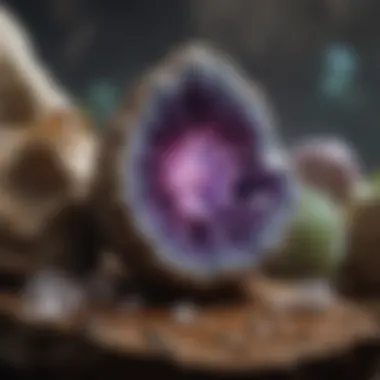
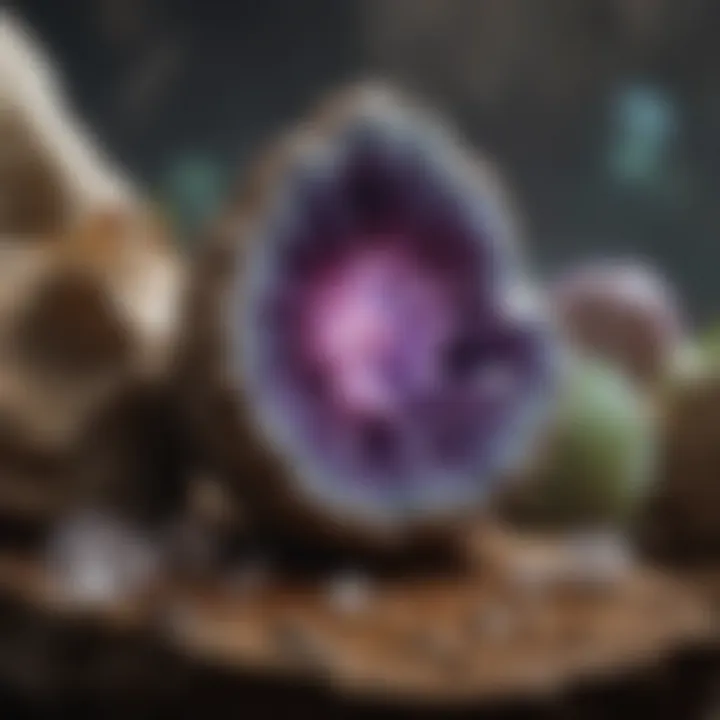
Record-sized geodes, like the one discovered in Cave of the Crystals in Naica, Mexico, push the envelope of what we consider possible in nature. These colossal geological wonders can measure up to 11 feet in length, featuring crystals that can weigh several tons.
The sheer scale of these specimens contributes to our understanding of geological timelines and environmental conditions that enable such growth. They serve as remarkable examples in the exploration of crystal formations and their physical limits.
While eye-catching, these record-sized geodes also highlight the fragility of such environments, urging collectors and researchers to consider preservation alongside appreciation. By fostering respect for these natural wonders, the community can work towards safeguarding the geode's future.
Collecting Geodes
Collecting geodes isn't just a hobby; it's a journey through time and nature's artistry. These unique formations hold the essence of the Earth's history within their rough exteriors. As enthusiasts delve into the world of geodes, they encounter not only unique physical specimens but also an opportunity to connect with the geological processes that birthed them. The benefits of collecting cannot be overstated, as each geode discovered is like unearthing a piece of art forged under immense pressure.
Identification Techniques
Field Assessments
Field assessments are vital for anyone interested in collecting geodes. This process involves scouting various terrains to determine conducive areas for geode finds. A key characteristic of field assessments is the need for geological knowledge – understanding different rock types and their formations can dramatically increase one's chances of success.
Through careful study, collectors can identify the specific places where geodes typically form, such as volcanic sites or sedimentary deposits. One unique aspect of field assessments is the thrill of exploration; it turns the hunt into an adventure. However, it has its challenges, too. Weather conditions can change swiftly, and the ruggedness of terrain may pose risks for collectors,
Visual Characteristics
When collecting geodes, visual characteristics play a crucial role in identifying potential specimens. The external surface often gives hints about the likely treasures within. A key element of these characteristics is recognizing different textures and colorations. Varieties in surface patterns can indicate the mineral content inside, providing clues about what to expect upon opening the rock. One advantage of focusing on visual traits is that even untrained eyes can develop a keen sense for distinguishing geodes from regular rocks, but this method is not foolproof; some deceivingly smooth stones can lead to disappointment.
Care and Maintenance
Cleaning Methods
Cleaning methods are essential for maintaining the beauty of collected geodes. Collectors often find themselves wrestling with dirt and mineral residues that cling stubbornly to the surfaces of these stones. A commonly employed method involves using a soft toothbrush and a solution of warm water with mild soap. This approach ensures that delicate crystals aren’t damaged. An appealing feature of this cleaning method is its effectiveness; most dirt comes off without scratching the surface. However, it's worth noting that some geodes need specialized cleaning techniques based on their mineral composition, which can pose a challenge for novices.
Display Considerations
Display considerations are pivotal for showcasing collected geodes. How a geode is presented can dramatically enhance its visual appeal. A key factor in this area is choosing the right lighting to highlight the crystal formations inside. Natural light can be beautiful but sometimes isn’t practical; thus, choosing the right display case with controlled lighting is essential.
Unique display ideas, such as incorporating geodes into home decor or creating themed displays, can make a collector's collection stand out as a centerpiece in any room. However, it’s important to remember that excessive exposure to light can fade colors in some specimens. Proper balancing is crucial here, ensuring enjoyment without compromising the geodes’ natural beauty.
The Significance of Geodes in Science
Geodes hold a unique place at the crossroads of beauty and scientific inquiry. They are not merely eye-catching natural formations; they serve as a valuable resource for various scientific fields, including mineralogy, geology, and education. Understanding the significance of geodes in these domains illuminates their role in both the practical and the aesthetic appreciation of Earth's geological processes. By diving into their mineralogical studies and educational value, we can grasp why these formations matter far beyond their stunning appearances.
Mineralogical Studies
Geodes are vital to mineralogical studies due to the wealth of information they provide about the Earth's geological history. The kind of crystals found within geodes, such as quartz, amethyst, or celestite, can reveal significant details about the conditions under which they formed. This information can further lead to a deeper understanding of igneous, sedimentary, and metamorphic processes.
For instance, consider an amethyst geode. The purple quartz crystals within it suggest specific conditions of temperature and pressure during formation. Researchers have been able to determine which volcanic gases and minerals were present, enhancing our understanding of volcanic activity and its influence on the surrounding environment. This exploration opens up discussions about ore deposits and the location of valuable resources within the Earth.
Moreover, mineralogists often analyze geodes to study phenomena such as crystal growth rates. They can observe how varying conditions affect the size and clarity of crystals, shedding light on broader mineral formation processes in nature.
Educational Value
Geology Classes
In academia, geodes hold considerable significance, especially in geology classes. They offer a tangible method for students to explore abstract concepts in mineralogy, crystallography, and geology. Rather than just relying on textbooks, students can study real-life examples to better understand how geodes form and the conditions necessary for their creation.
What makes geology classes that include geodes beneficial is their interactive nature. Students can engage in field trips where they look for geodes, learn to identify these unique rocks, and discover the joy of collecting. This hands-on experience enhances retention and comprehension and helps foster a genuine passion for geology.
One key characteristic of these classes is the integration of geodes into visual aids and demonstrations. Instructors often showcase cross-sections or polished geodes to illustrate interior features and crystal growth, which allows students to visualize concepts clearly. The appeal of geodes can motivate even students who may initially find geology dull.
Public Exhibitions
Public exhibitions serve another critical purpose in promoting the significance of geodes. Museums often display stunning specimens that draw in the public, raising awareness about geology and mineralogy. These exhibitions provide visitors a chance to see geodes up close, highlighting both their beauty and their scientific importance.
The ability to engage with geodes in exhibitions allows the community to appreciate the natural world and encourages curiosity about geological processes. Educators often leverage these settings for outreach programs, leading guided tours that explain how geodes form and their various types. This approach helps demystify science, making it accessible to the general public.
However, while public exhibitions effectively raise awareness, one must consider the potential downside; often, the focus on the aesthetic effects may overshadow the scientific significance. It’s crucial that exhibitions strike a balance, offering enough background knowledge to present geodes both as scientific specimens and as objects of beauty, to ensure a well-rounded understanding.
"Geodes are not just pretty face rocks; they are ancient time capsules whispering tales of our planet's past."
The End
The exploration of geodes reveals their significance far beyond mere aesthetics; they embody a compelling intersection of beauty and science. The journey from rock to stunning crystal formations showcases not just the geological processes beneath the earth's surface, but also humanity's enduring quest for understanding these natural wonders. In this article, we have highlighted the key aspects of geodes, touching on their physical characteristics, formation, and diverse types. Such knowledge is not just for the amateur rock hound, but is immensely valuable for teachers, students, and collectors alike, emphasizing the deeper layers of significance within these seemingly simple structures.
The Lasting Appeal of Geodes
The allure of geodes doesn't only lie in their captivating appearances — though entering a cave brimming with crystal-laden stones can feel like walking into a sparkling dream. Geodes remind us of the profound beauty that can emerge from the earth when the right conditions align. The variability in shape, size, and interior structure means that no two geodes are identical, much like the people who collect them. This uniqueness encourages collectors to seek out and cherish their finds, often giving way to passionate discussions about the rocks they've acquired and the stories they hold.
Additionally, geodes often symbolize prosperity and treasure in various cultures, encouraging collectors to hold onto them not just for their visual appeal but for the emotional connections they foster. Perhaps possessing a well-crafted geode invokes a sense of groundedness amidst chaos.
Future Discoveries and Research
As we combine technology with geology, the potential for future discoveries is vast. Innovations in mineralogy and geochemical analyses may open doors to understanding the conditions that lead to geode formation more clearly than ever before. Researchers can dive deeper, analyzing elements within geodes to learn about the historical climates and environments in which they were formed.
Community enthusiasts and collectors can also contribute to this evolving landscape. Forums like reddit.com show lively discussions on the latest findings, or on particular types of geodes that captivate the public's imagination. Future exhibitions could center around showcasing these insights, bridging the gap between science and art, and allowing collectors to appreciate not just the physical beauty of geodes, but the stories they tell of past eras and latent geological processes.
The pursuit of knowledge in geodes exemplifies the union of beauty and comprehensibility in nature, ensuring that their fascination will endure, just as the rocks themselves do, quietly telling their tales through the ages.



